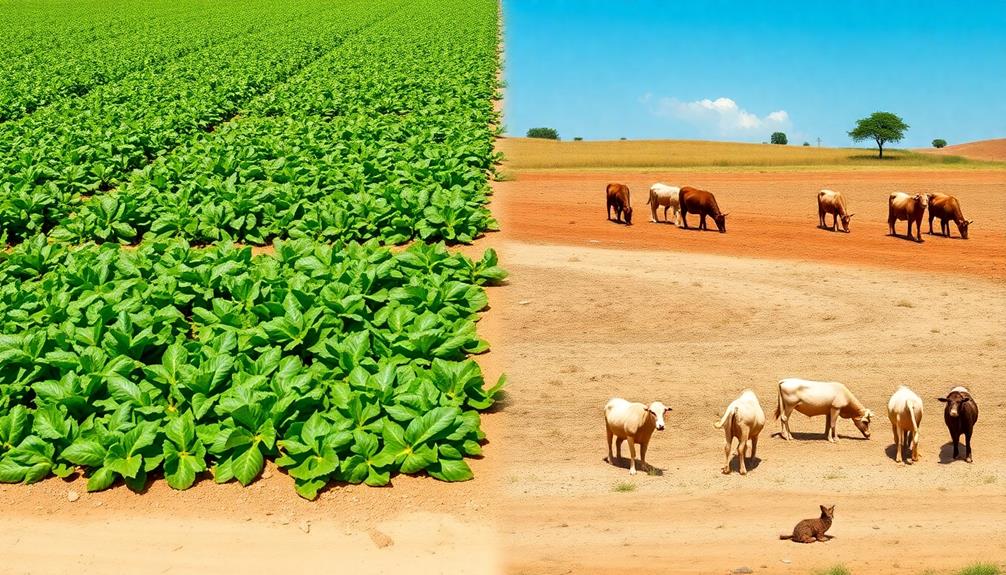Your dietary choices, from the Standard American Diet to plant-based options, heavily influence the environment and your carbon footprint. High meat diets produce significant greenhouse gas emissions, while plant-based diets offer the lowest impact. For instance, beef emits around 60 kg of CO2-equivalents per kilogram, compared to just 1 kg for peas. Sustainable practices, like local sourcing and reducing food waste, can further minimize your impact. By making informed choices, you not only boost your health but also help the planet. Discovering more about these diets can provide you with deeper insights into sustainable eating.
Key Takeaways
- The Standard American Diet significantly contributes to greenhouse gas emissions, primarily due to high meat consumption, especially beef.
- Plant-based diets, like vegan and Mediterranean, have lower carbon footprints, reducing overall greenhouse gas emissions.
- Livestock production accounts for roughly 26% of global greenhouse gas emissions, emphasizing the environmental impact of animal-source foods.
- Agriculture uses about 70% of global freshwater, with meat and dairy production consuming significantly more water than plant-based foods.
- Transitioning to plant-rich diets can alleviate land use pressures, supporting biodiversity and reducing deforestation.
Overview of Diets

When considering the environmental impact of various diets, it's essential to recognize how different eating patterns affect both our health and the planet.
The Standard American Diet (SAD) is heavy on animal-based foods, leading to significant greenhouse gas emissions and health impacts like obesity and heart disease. In contrast, the Mediterranean Diet focuses on local, seasonal foods, promoting a lower carbon footprint while offering health benefits such as reduced cardiovascular disease risk.
Additionally, embracing a diet rich in diverse flavors, such as those found in Brazilian cuisine, can contribute to sustainability by utilizing local ingredients and reducing reliance on imported foods.
Vegan diets stand out for their minimal environmental impact, often linked to the lowest carbon footprints. The health benefits you gain from veganism, however, depend on the quality and variety of the plant-based foods you choose.
Other diets like the Paleo Diet may yield positive health outcomes but come with a higher carbon impact due to their reliance on animal-based foods. Similarly, the Keto Diet's environmental effects can vary, largely influenced by the sourcing of its high-fat, animal-derived proteins, which contribute to greenhouse gas emissions.
Understanding these diets helps you make informed choices that not only benefit your health but also contribute positively to the environment.
Carbon Footprint Analysis

When you compare carbon emissions from different diets, the contrast between plant-based and animal-based foods becomes clear.
For instance, producing beef releases around 60 kg of CO2-equivalents per kilogram, while peas only add about 1 kg.
Additionally, incorporating more vegetarian meals, such as Mushroom Masala, can greatly reduce your carbon footprint.
Understanding these differences can help you make more sustainable food choices that lower your carbon footprint.
Diet Carbon Emissions Comparison
Diets can have dramatically different carbon footprints, influencing the environment in various ways. Your dietary intakes play an essential role in determining the greenhouse gas emissions linked to food consumption.
For instance, animal-source foods, especially beef and dairy, contribute considerably to emissions, with beef producing around 60 kg of CO2-equivalents per kilogram. In fact, these animal products account for 80% of methane and nitrous oxide emissions and 56% of all food-related greenhouse gas emissions.
Conversely, incorporating dishes like Red-Braised Pork Belly can offer a rich flavor experience while being mindful of portion sizes and frequency of consumption to minimize environmental impact. Shifting towards plant-based diets can lead to considerable reductions in your carbon footprint. Plant foods like peas emit only about 1 kg of CO2-equivalents per kilogram, making them far more environmentally sustainable.
Studies show that dietary changes can mitigate over 8% of global emissions, emphasizing the importance of food choices in combating climate change.
The Standard American Diet (SAD), characterized by high meat and dairy consumption, results in a considerable environmental impact. In contrast, diets such as vegan, climatarian, and Mediterranean not only exhibit lower carbon footprints but also promote better health outcomes.
Making mindful choices can greatly influence both your health and the planet's future.
Plant-Based vs. Animal-Based
Making informed choices about your food can greatly impact the planet's health. When you compare plant-based and animal-based diets, the carbon footprint of these options tells a compelling story. Producing just 1 kg of beef emits around 60 kg of CO2-equivalents, while 1 kg of peas emits only 1 kg. This stark difference highlights the significant environmental impact of animal-based foods.
Additionally, incorporating traditional Ethiopian dishes like Yetimatim Fitfit can provide nutritious plant-based options that are both delicious and sustainable. Animal-source foods contribute to 80% of methane and nitrous oxide emissions, which are potent greenhouse gas emissions that exacerbate climate change. By shifting your dietary habits toward more plant-based foods, you can help reduce these emissions.
Studies show that cutting back on meat consumption can lead to substantial reductions in overall carbon footprints. In fact, livestock production accounts for about 26% of global greenhouse gas emissions, emphasizing the urgent need for sustainable diets.
Food Sourcing Impact
Understanding the carbon footprint of food sourcing reveals the critical role your dietary choices play in environmental sustainability. Food production contributes to about 26% of global greenhouse gas emissions, with livestock and fisheries responsible for around 30% of those emissions.
For instance, producing just 1 kg of beef emits approximately 60 kg of CO2-equivalents, while plant-based foods like peas emit only about 1 kg per kg produced. This stark difference highlights the significant impact of your food sourcing decisions. Seasonal dishes like Nettle and Potato Soup not only provide nutritional benefits but also promote the use of locally sourced, plant-based ingredients, further reducing your carbon footprint.
By opting for plant-based diets, you can make a meaningful contribution to reducing overall carbon emissions, which is essential for combating climate change. The carbon footprint of individual food items varies greatly, with animal-based foods generally showing higher emissions than plant-based alternatives.
Embracing sustainable agriculture practices, such as improved feeding techniques and efficient supply chains, can further lower the carbon footprint associated with food sourcing.
Ultimately, your choices matter. By prioritizing plant-rich diets and supporting sustainable practices, you'll be actively participating in the fight against climate change while promoting a healthier planet for future generations.
Water Usage in Diets
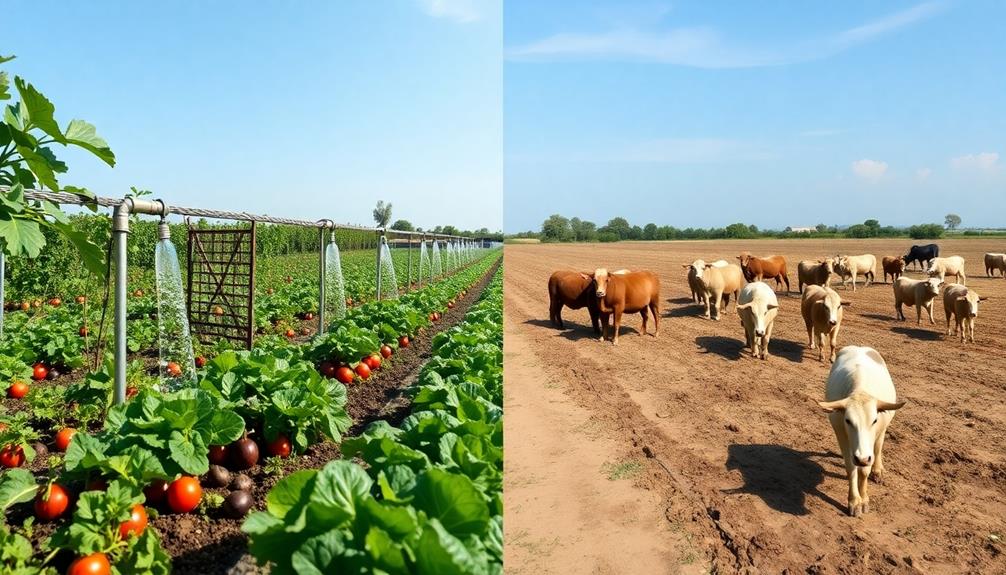
When pondering the environmental impact of our food choices, water usage stands out as a critical factor. Agriculture accounts for about 70% of global freshwater withdrawals, making it essential to understand the water footprint associated with different diets.
Remarkably, dairy and meat production require considerably more water compared to plant-based foods. For example, producing 1 kg of beef uses around 15,000 liters of water, while 1 kg of vegetables only needs about 300 liters.
Additionally, traditional Mexican dishes like chilaquiles and tamales showcase the use of corn, a crop that typically has a lower water footprint compared to animal products.
Here are some key points to reflect on regarding water usage in diets:
- Dairy products demand considerable water resources, contributing to a larger water footprint.
- Plant-based foods generally require less water, making them a more sustainable choice.
- Agricultural practices that promote efficient water management can reduce overall water stress.
- Nutrient pollution from farming can lead to eutrophication, harming freshwater resources.
Land Use Considerations
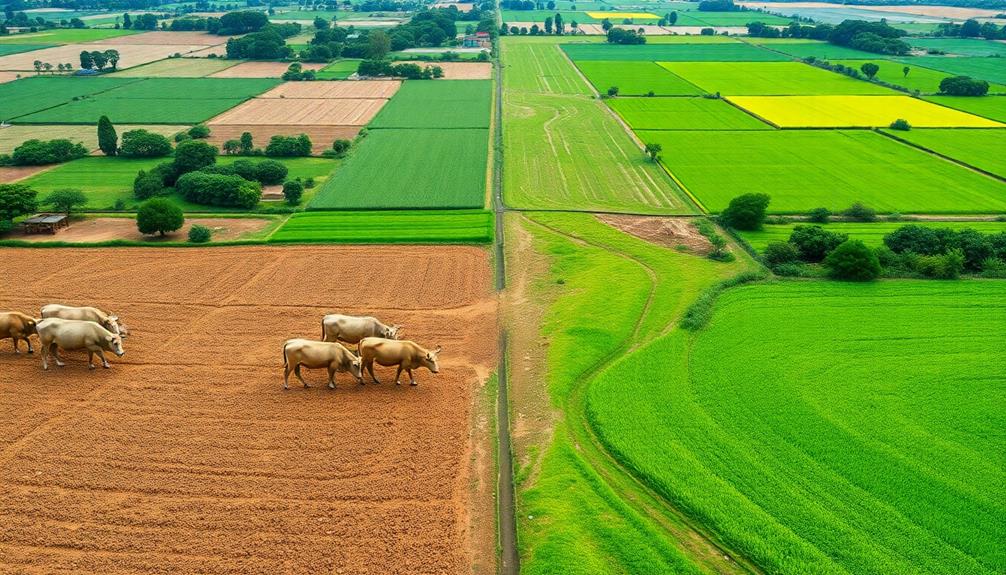
Agriculture occupies nearly 50% of the world's habitable land, with a staggering 75% of that dedicated to livestock grazing and feed crops. This heavy land use greatly impacts biodiversity and natural habitats. When you evaluate the conversion of forests and other natural ecosystems into agricultural land, it becomes clear that deforestation is a primary driver of habitat loss, threatening global biodiversity.
For instance, traditional dishes like Muamba De Galinha often rely on ingredients that demand extensive land use, further emphasizing the necessity for sustainable practices. You've likely heard about the peak agricultural land use we've reached after centuries of expansion, emphasizing the urgent need for improvements in agricultural efficiency.
Sustainable land management practices are vital to mitigating the environmental burden of agricultural emissions and the broader environmental impacts of food production. Implementing these practices can help protect wildlife and ecosystems, especially in regions where biodiversity loss is acute.
Additionally, restoring natural lands can support wildlife recovery, enhancing biodiversity and creating a more resilient environment. By prioritizing balanced agricultural practices, you can contribute to a more sustainable food system that respects both the planet and its inhabitants.
It's important to take these land use factors into account when evaluating the overall impact of your dietary choices.
Health Implications of Diets
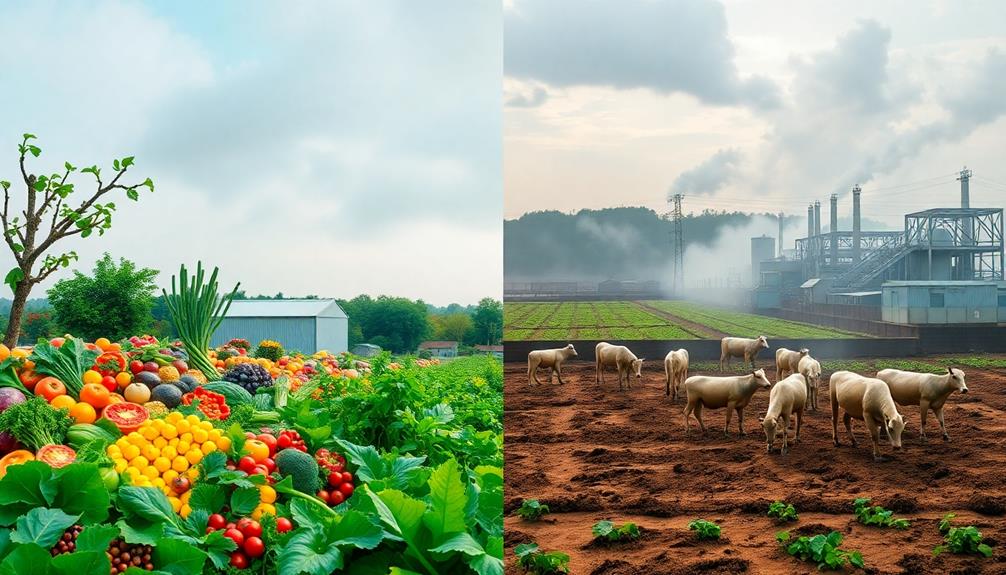
Dietary choices greatly influence your health, with poor eating patterns contributing to 25% of adult deaths globally. The Standard American Diet, high in meat and dairy while low in fruit and vegetables, leads to preventable diseases like obesity and type II diabetes.
Shifting towards healthier diets can notably improve your well-being and help reduce global greenhouse gas emissions. For instance, incorporating traditional dishes such as Dorayaki (Red Bean Pancake) can provide a delightful way to enjoy sweet treats while emphasizing the importance of moderation and balance. Furthermore, by diversifying your diet with various cuisines, you can explore different flavors and ingredients that not only satisfy but also nourish the body. The texture’s impact on food enjoyment also plays a crucial role; smooth, creamy, or crispy textures can elevate the dining experience, making healthier choices more appealing. Ultimately, mindful eating that considers both flavor and texture can make the shift to better dietary habits more enjoyable and sustainable.
Consider these key points:
- Nutrient Quality: A Mediterranean diet, rich in whole foods and healthy fats, is linked to lower cardiovascular disease risk.
- Plant-Rich Diets: Adopting more balanced, plant-rich diets can help reduce the prevalence of obesity and related health issues.
- Vegan Diets: While vegan diets can offer health benefits, it's essential to guarantee they're well-planned to avoid nutrient deficiencies.
- Health and Environment: Following food-based dietary guidelines can't only improve your health but also help the planet stay within its planetary boundaries.
Sustainable Dietary Choices
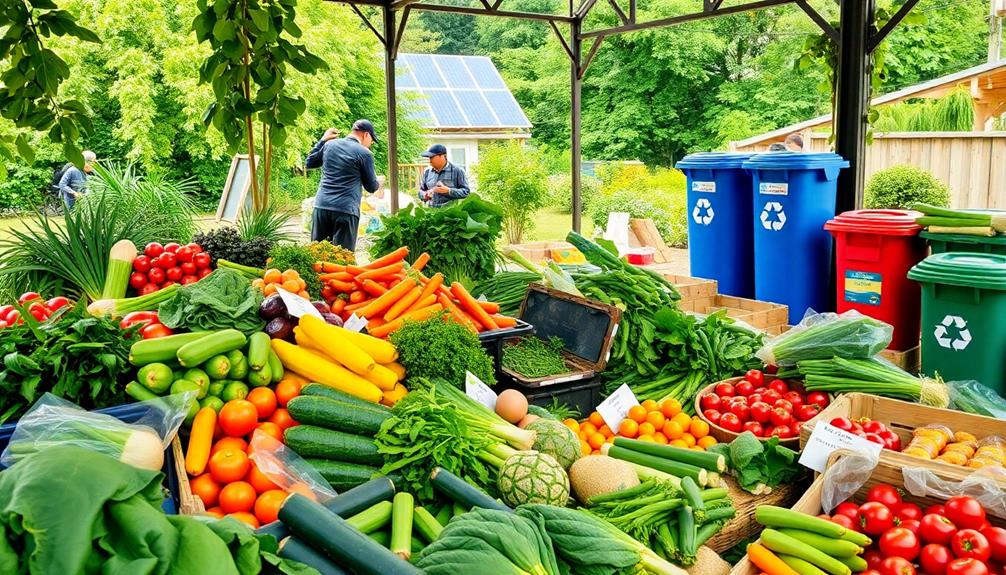
When you choose plant-based foods, you're not only lowering your carbon footprint but also promoting a healthier planet.
Incorporating local street foods like Khao Niao Sangkhaya can help you enjoy delicious flavors while supporting sustainable practices.
Reducing food waste and opting for local, seasonal ingredients can further amplify these benefits, helping to conserve biodiversity and cut down on transportation emissions.
Plant-Based Benefits
A plant-based diet offers numerous environmental benefits that can markedly reduce your carbon footprint.
By shifting away from animal-source foods, you can considerably cut down on greenhouse gas emissions. For instance, traditional dishes like Agnolotti showcase the versatility of plant ingredients, emphasizing how flavorful vegetarian options can be.
Here are four key benefits of adopting a plant-based diet:
- Lower Carbon Footprint: Producing beef emits about 60 kg of CO2-equivalents per kg, while plant-based foods like peas only emit about 1 kg.
- Reduced Emissions: Dietary changes away from meat and dairy can potentially mitigate over 8% of global emissions.
- Sustainable Resource Use: Vegans demonstrate the lowest greenhouse gas emissions and promote better land and water use practices compared to meat-eaters.
- Health and Sustainability: A plant-rich diet not only supports your personal health but also contributes to environmental sustainability by lessening the demand for resource-intensive animal agriculture.
Reducing Food Waste
Reducing food waste is essential for achieving sustainable dietary choices and protecting the environment. Did you know that approximately one-third of all food produced globally is wasted? That's about 1.3 billion tons annually, leading to unnecessary resource consumption and a significant contribution to greenhouse gas emissions.
By adopting effective food management practices, such as meal planning and proper storage, you can drastically decrease your household food waste.
Composting is another powerful tool in your arsenal. It not only helps reduce methane emissions and CO2 but also enriches soil health, promoting sustainable agriculture. When you compost, you're diverting organic waste from landfills and contributing to a healthier planet.
Moreover, engaging in community programs that facilitate food sharing can minimize waste while addressing food insecurity. By redistributing surplus food, you can help those in need and reduce the overall food waste cycle.
Local Sourcing Advantages
Choosing to source your food locally offers numerous benefits that extend beyond just taste. By opting for local sourcing, you can actively contribute to a more sustainable food system while enjoying fresher produce.
Here are some key advantages:
- Reduced Transportation Emissions: Local sourcing minimizes transportation emissions, which account for 18% of food-related greenhouse gas emissions in supply chains.
- Lower Carbon Footprint: Supporting local producers reduces the carbon footprint linked to long-distance food transport, especially for perishable items.
- Enhanced Food Security: Local food systems foster community connections and sustainable agricultural practices, making your community more resilient.
- Less Food Waste: Shorter supply chains typically result in less spoilage during transportation and distribution, helping to minimize food waste.
Comparative Environmental Impact
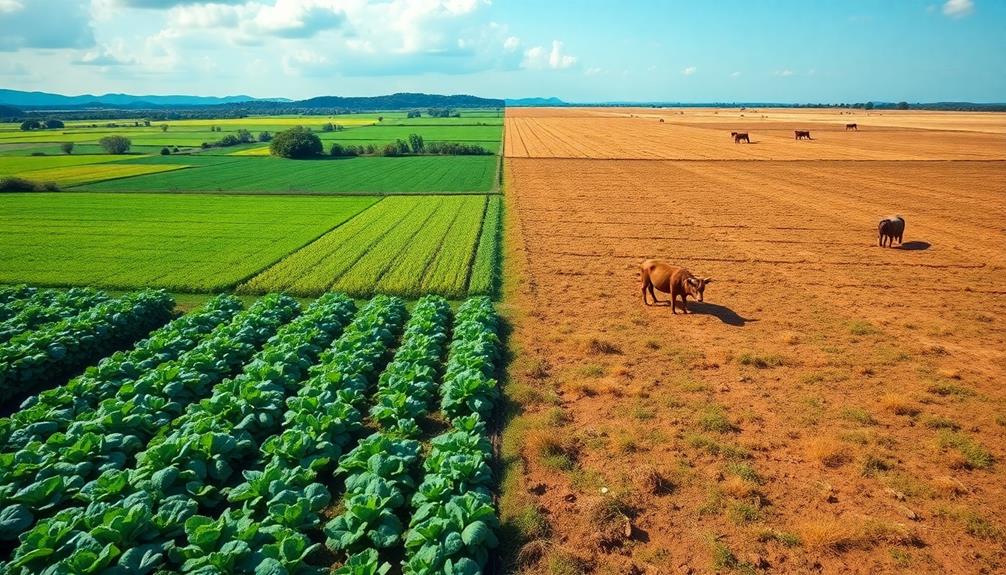
The environmental impact of various diets reveals stark contrasts that can influence both personal health and the planet's well-being. The Standard American Diet (SAD) has a high carbon footprint, primarily due to its heavy reliance on animal products. This diet contributes considerably to greenhouse gas emissions, accounting for over 33% of global totals from food production.
In sharp contrast, plant-based diets show the lowest emissions, with meat and dairy responsible for 80% of methane and nitrous oxide emissions, and 56% of food-related greenhouse gas emissions.
If you're looking for a middle ground, the Mediterranean diet offers a lower carbon impact while promoting local, seasonal foods that enhance sustainability. Generally, plant-based foods require less land, water, and energy than their animal-based counterparts. For instance, producing one kilogram of beef emits about 60 kg of CO2-equivalents, whereas peas only emit 1 kg.
Case Studies of Diets
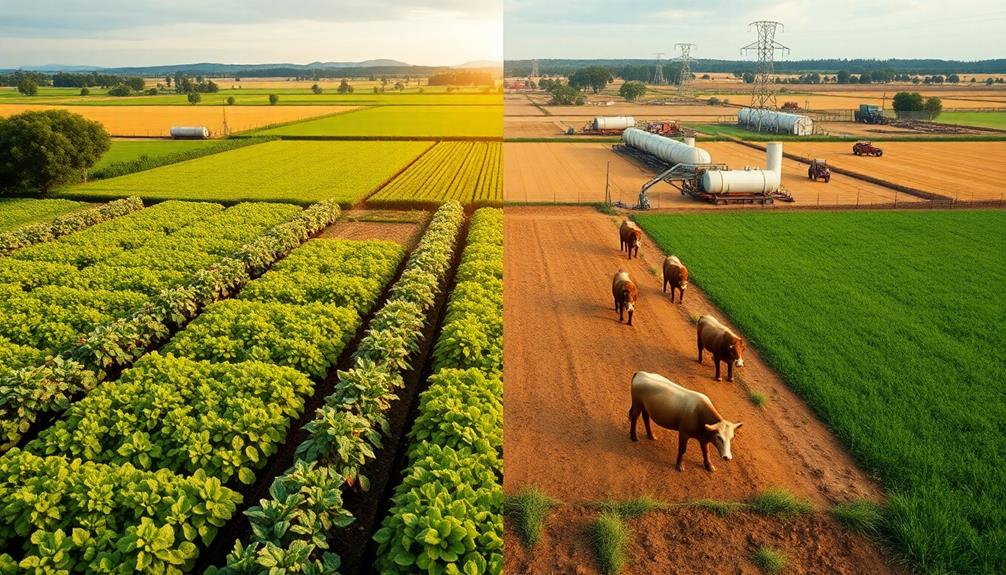
Examining specific diets reveals how lifestyle choices can vary in their environmental impact while also affecting health outcomes. Each diet comes with its own carbon footprint and associated greenhouse gas emissions. Here are four case studies:
- Standard American Diet (SAD): This diet heavily relies on meat and dairy, resulting in high carbon emissions and considerable greenhouse gas contributions from livestock production.
- Mediterranean Diet: Emphasizing whole foods and healthy fats, this diet has a lower carbon impact. It's linked to reduced disease risk, with only about 5% of the U.S. population currently adopting it.
- Vegan Diets: These show the lowest environmental impacts, boasting considerably lower carbon footprints compared to meat-based diets. However, health impacts depend on food quality and nutrient density.
- Paleo Diet: While generally promoting positive health effects, this diet includes resource-intensive animal-based foods, leading to a higher carbon impact.
Understanding these case studies helps you see how diet choices can shape both your health and the environment.
Future Directions in Diet Research

As we look ahead, future research in diet must zero in on the long-term impacts of dietary patterns on carbon emissions. You need to understand how individual food items—from cultivation to consumption—contribute to overall emissions. By investigating the nutritional balance of various diets alongside their environmental sustainability, you can gain insights into the trade-offs between health and ecological impacts.
Moreover, studies should focus on the diversity of foods within specific diets. This means considering regional and Canadian food items to paint a more thorough picture of dietary impacts. Increased public awareness of the environmental consequences of dietary choices is vital, and research should highlight the link between your eating habits and climate change.
Additionally, exploring alternative proteins and sustainable agricultural practices can greatly reduce the environmental footprint of food systems. These innovations could reshape food production and consumption in ways that promote healthier living while preserving our planet.
Ultimately, prioritizing these research directions won't only inform policy decisions but also empower individuals like you to make more sustainable food choices that align with both health goals and ecological well-being.
Frequently Asked Questions
How Do Different Diets Impact the Environment?
You'll find that your food choices shape the environment considerably. Eating more plant-based foods lowers your carbon footprint, while heavy meat and dairy consumption ramps up greenhouse gas emissions and resource depletion. Choose wisely!
What Diet Has the Greatest Environmental Impact?
If you're looking for the diet with the greatest environmental impact, it's the Standard American Diet. Its heavy reliance on meat and dairy greatly contributes to greenhouse gas emissions, particularly methane from livestock.
What Impact Do Our Diet Choices Have on the Environment?
Imagine your plate as a canvas; each meal you choose paints a story. Your diet choices shape the world, affecting air, water, and wildlife. By selecting wisely, you can create a masterpiece of sustainability.
Which Diet Has the Least Environmental Impact on Our Planet?
If you're looking for the diet with the least environmental impact, the vegan diet stands out. It reduces greenhouse gas emissions considerably, requiring fewer resources and helping you contribute positively to the planet's health.
Conclusion
In choosing your diet, you're not just selecting meals; you're shaping the planet's future. By understanding the carbon footprint, water usage, and land use of various diets, you can make informed choices that benefit both your health and the environment. Embracing sustainable dietary options not only lessens your impact but also promotes a healthier lifestyle. So, whether you're cutting back on meat, exploring plant-based foods, or prioritizing local produce, each choice you make can lead to a greener, healthier world.
